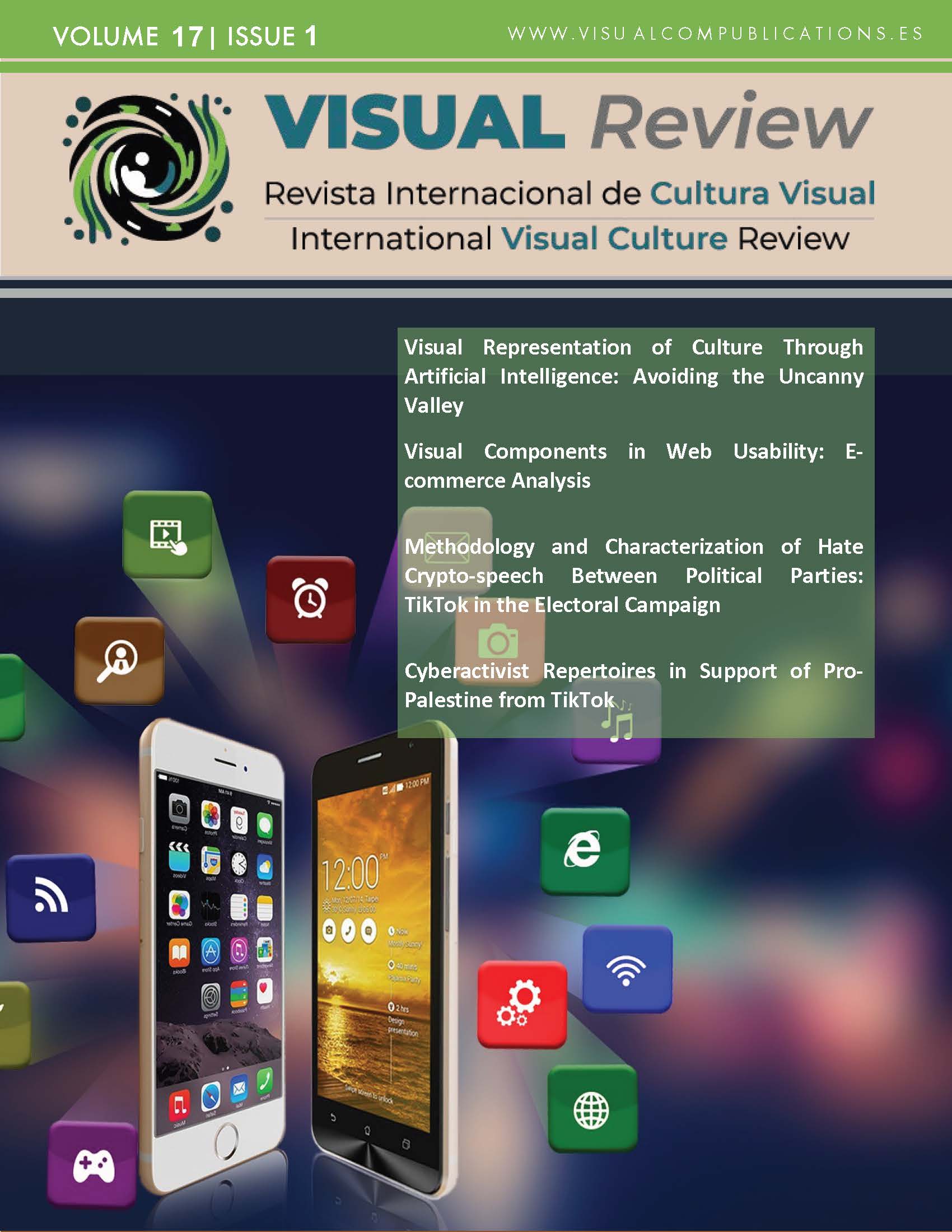Componentes Visuales en la Usabilidad Web
Análisis del comercio electrónico
DOI:
https://doi.org/10.62161/revvisual.v17.5357Palabras clave:
usabilidad, Comercio electrónico, Tiendas minoristas, Comportamiento de compra, Experiencia de usuario, Diseño de interfaz, Contenido digitalResumen
El auge del comercio electrónico junto con la necesidad de mejorar la experiencia en línea de los consumidores hace necesario estudiar la parte visual de la web, es decir, la usabilidad y sus indicadores. Esta investigación tiene como objetivo contribuir dentro del campo de estudio del comercio electrónico a través de un estudio empírico basado en un modelo de ecuaciones estructurales (SEM) en el que se medirán los cinco indicadores de usabilidad (aprendizaje, eficiencia, recuerdo, errores y satisfacción) y la medida en que influyen en la usabilidad de un comercio electrónico. El estudio arroja resultados significativos dentro del área de investigación.
Descargas
Estadísticas globales ℹ️
|
807
Visualizaciones
|
242
Descargas
|
|
1049
Total
|
|
Citas
Ahmad, I., Akbar, R. & Javed, M. A. (2023). Nexus between e-service quality and e-customer satisfaction through functional and hedonic values: case of online shopping in Pakistan. Kybernetes. https://doi.org/10.1108/K-06-2023-1146 DOI: https://doi.org/10.1108/K-06-2023-1146
Ali, W., Riaz, O., Mumtaz, S., Khan, A.R., Saba, T. & Bahaj, S.A. (2022). Mobile Application Usability Evaluation: A Study Based on Demography. IEEEAccess, 10, 41512-41524, https://doi.org/10.1109/ACCESS.2022.3166893 DOI: https://doi.org/10.1109/ACCESS.2022.3166893
Allah, K.K., Ismail, N.A., Ghaban, W, Gazen, N.A. & Nasser, M. (2023). Adaptable Web Search User Interface Model for the Ederly. KSII Transactions on Internet and Information Systems, 17, 9, 2436-2457, https://doi.org/10.3837/tiis.2023.09.008 DOI: https://doi.org/10.3837/tiis.2023.09.008
Alhejji, S., Albesher, A., Wahsheh, H. & Albarrak, A. (2022). Evaluating and Comparing the Usability of Mobile Banking Applications in Saudi Arabia. Information, 13, 12, 559, https://doi.org/10.3390/info13120559 DOI: https://doi.org/10.3390/info13120559
AlSalem, T.S. & AlShamari, M.A. (2023). Assessing Interactive Web-Based Systems Using Behavioral Measurement Techniques. Future internet, 15, 11, 365, https://doi.org/10.3390/fi15110365 DOI: https://doi.org/10.3390/fi15110365
Barakovic, S., Skorin-Kapov, L. & Barakovic Husic, J. (2023). The Impacct of QoE Factors on the Perception of Constructs Comprising Information Quality, Usability, and Aesthetics in Mobile Web Browsing. International Journal of Human-Computer Interaction, https://doi.org/10.1080/10447318.2023.2260982 DOI: https://doi.org/10.1080/10447318.2023.2260982
Behnam, F., Khajouei, R., Nabizadeh, A.H., Saedi, S. & Ghaemi, M.M. (2023). Usability evaluation of emergency information systems in educational hospitals in Kerman, Iran. BMC Medical Informatics and Decision Making, 23, 277, https://doi.org/10.1186/s12911-023-02357-3 DOI: https://doi.org/10.1186/s12911-023-02357-3
Belk, M., Fidas, C., Germanakos, P. & Samaras, G. (2017). The interplay between humans, technology and user authentication: A cognitive processing perspective. Computers in Human Behavior, 76, 184-200, https://doi.org/10.1177/20503121231180413 DOI: https://doi.org/10.1016/j.chb.2017.06.042
Brown, W., Yen, P.-Y., Rojas, M. & Schnall, R. (2013). Assessment of the Health IT Usability Evaluation Model (Health-ITUEM) for evaluating mobile health (mHealth) technology. Journal of Biomedical Informatics, 46, 6, 1080-1087, https://doi.org/10.1016/j.jbi.2013.08.001. DOI: https://doi.org/10.1016/j.jbi.2013.08.001
Calisir, F. & Calisir, F. (2004). The relation of interface usability characteristics, perceived usefulness, and perceived ease of use to end-user satisfaction with enterprise resource planning (ERP) systems. Computers in Human Behavior, 20, 505-515, https://doi.org/10.1016/j.chb.2003.10.004 DOI: https://doi.org/10.1016/j.chb.2003.10.004
Cavazos-Arroyo, J., Máynez-Guaderrama, A. & Vargas-Salgado, M. M. (2024). Satisfaction with online clothing shopping: an analysis of its antecedents. Retos Revista de Ciencias de la Administración y Economía, 14(27), 35-50. https://doi. org/10.17163/ret.n27.2024.03 DOI: https://doi.org/10.17163/ret.n27.2024.03
Chiu, C. M., Hsu, M. H., Sun, S. Y., Lin, T. C. & Sun, P. C. (2005). Usability, quality, value and e-learning continuance decisions. Computers & education, 45(4), 399-416. https://doi.org/ 10.1016/j.compedu.2004.06.001 DOI: https://doi.org/10.1016/j.compedu.2004.06.001
Cristancho-Triana, G. J., Cancino-Gómez, Y. A. & Ninco-Hernández, F. A. (2024). Factors influencing sustainable consumption behaviour in generation Z. Retos Revista de Ciencias de la Administración y Economía, 14(27), 51-67. https://doi.org/10.17163/ret.n27.2024.04 DOI: https://doi.org/10.17163/ret.n27.2024.04
Cuesta‐Valiño, P., Gutiérrez‐Rodríguez, P., García‐Henche, B. & Núñez‐Barriopedro, E. (2024). The impact of corporate social responsibility on consumer brand engagement and purchase intention at fashion retailers. Psychology & Marketing, 41(3), 649-664. https://doi.org/10.1002/mar.21940 DOI: https://doi.org/10.1002/mar.21940
Cuesta-Valiño, P., Gutiérrez-Rodríguez, P. & Núnez-Barriopedro, E. (2022). The role of consumer happiness in brand loyalty: a model of the satisfaction and brand image in fashion. Corporate Governance, Vol. 22 No. 3, pp. 458-473. https://doi.org/10.1108/CG-03-2021-0099 DOI: https://doi.org/10.1108/CG-03-2021-0099
Dogra, P. & Kaushal, A. (2023). Investigating factors affecting trust and purchase intention towards online websites: structural equation modelling approach. International Journal Of Internet Marketing And Advertising, 18(1), 98. https://doi.org/10.1504/ijima.2023.128151 DOI: https://doi.org/10.1504/IJIMA.2023.128151
Domínguez Vila, T., Alén González, E., Araújo Vila, N. & Fraiz Brea, J.A. (2021). Indicators of Website Features in the User Experience of E-Tourism Search and Metasearch Engines. Journal of Theoretical and Applied Electronic Commerce Research, 16, 1, 18-36, https://doi.org/10.4067/S0718-18762021000100103 DOI: https://doi.org/10.4067/S0718-18762021000100103
El-Aasar, S.A. & Farghali, G.F. (2022). Predictive study of the factors and challenges affecting the usability of e-learning platforms in the light of COVID-10. International Journal of Education in Mathematics, Science, and Technology, 10, 3, 568-589, https://doi.org/10.46328/ijemst.2428 DOI: https://doi.org/10.46328/ijemst.2428
Gallardo-Camacho, J. & Melendo-Rodríguez-Carmona, L. (2023). The use of QR codes to fuel transmedia strategy in the ecosystem of audiovisual media groups. Profesional de la información, v. 32, n. 2, e320216.https://doi.org/10.3145/epi.2023.mar.16 DOI: https://doi.org/10.3145/epi.2023.mar.16
Gutiérrez-Rodríguez, P., Villarreal, R., Cuesta-Valiño, P. & Blozis, S. (2020). A PLS-SEM approach to understanding E-SQ, e-satisfaction and e-loyalty for fashion e-retailers in Spain. Journal of Retailing and Consumer Services, 57, 102201. https://doi.org/10.1016/j.jretconser.2020.102201 DOI: https://doi.org/10.1016/j.jretconser.2020.102201
Hair, J., Ringle, C. & Sarstedt, M. (2011). PLS-SEM: indeed a silver bullet, Journal of Marketing Theory and Practice, 19, 2, 139-151. https://doi.org/10.2753/MTP1069-6679190202 DOI: https://doi.org/10.2753/MTP1069-6679190202
Henseler, J. (2018). Partial least squares path modeling: Quo vadis? Quality & Quantity, 52(1), 1-8. https://doi.org/10.1007/s11135-018-0689-6 DOI: https://doi.org/10.1007/s11135-018-0689-6
Henseler, J., Müller, T. & Schuberth, F. (2018). New Guidelines for the Use of PLS Path Modeling in Hospitality, Travel, and Tourism Research, Ali, F., Rasoolimanesh, S.M. and Cobanoglu, C. (Ed.) Applying Partial Least Squares in Tourism and Hospitality Research, Emerald Publishing Limited, Leeds, pp. 17-33. https://doi.org/10.1108/978-1-78756-699-620181002 DOI: https://doi.org/10.1108/978-1-78756-699-620181002
Hernández Sampieri, R., Fernández Collado, C. & Baptista Lucio, P. (2007). Fundamentos de metodología de la investigación. Mc Graw Hill
Hornbæk, K. (2006). Current practice in measuring usability: Challenges to usability studies and research. International Journal of Human-Computer Studies, 64, 2, 79-102, https://doi.org/10.1016/j.ijhcs.2005.06.002 DOI: https://doi.org/10.1016/j.ijhcs.2005.06.002
Hu, L. T. & Bentler, P. M. (1999). Cutoff criteria for fit indexes in covariance structure analysis: Conventional criteria versus new alternatives. Structural equation modeling: a multidisciplinary journal, 6(1), 1-55. https://doi.org/10.1080/10705519909540118 DOI: https://doi.org/10.1080/10705519909540118
Huang, Z. & Benyoucef, M. (2013). From e-commerce to social commerce: A close look at design features. Electronic Commerce Research and Applications, 12(4), 246-259. http://dx.doi.org/10.1016/j.elerap.2012.12.003 DOI: https://doi.org/10.1016/j.elerap.2012.12.003
Jeng, J. (2005a). Usability Assessment of Academic Digital Libraries: Effectiveness, Efficiency, Satisfaction, and learnability. Libri, 55(2-3), 96-121. https://doi.org/10.1515/LIBR.2005.96 DOI: https://doi.org/10.1515/LIBR.2005.96
Jeng, J. (2005b). What Is Usability in the Context of the Digital Library and How Can It Be Measured? Information Technology and Libraries, 24, 2, 47-56, https://doi.org/10.6017/ital.v24i2.3365 DOI: https://doi.org/10.6017/ital.v24i2.3365
Joshi, R., Garg, P. & Kamboj, S. (2023). Examining the effects of brand authenticity and brand identification on consumers’ willingness to pay premium. International Journal Of Internet Marketing And Advertising, 19(1/2), 1-19. https://doi.org/10.1504/ijima.2023.132717 DOI: https://doi.org/10.1504/IJIMA.2023.132717
Kekre, S., Krishnan, M.S. & Srinivasan, K. (1995). Drivers of Customer Satisfaction for Software Products: Implications for Design and Service Support. Management Science, 41, 9, https://doi.org/10.1287/mnsc.41.9.1456 DOI: https://doi.org/10.1287/mnsc.41.9.1456
Kumar, B., Roy, S., Singh, K.U., Pande, S.K., Kumar, A., Sinha, A., Shukla, S., Shah, M.A. & Rasool, A. (2023). A Static Machine Learning Based Evaluation Method for Usability and Security Analysis in E-Commerce Website. IEEEAccess, 11, 40488-40510, https://doi.org/10.1109/ACCESS.2023.3247003 DOI: https://doi.org/10.1109/ACCESS.2023.3247003
Kureerung, P., Ramingwong, L., Ramingwong, S., Cosh, K. & Eiamkanitchat, N. (2022). A Framework for Designing Usability: Usability Redesign of a Mobile Government Application. Information, 13, 10, 470, https://doi.org/10.3390/info13100470 DOI: https://doi.org/10.3390/info13100470
Lacka, E. & Chong, A. (2016). Usability perspective on social media sites’ adoption in the B2B context. Industrial Marketing Management, 54, 80-91, https://doi.org/10.1016/j.indmarman.2016.01.001 DOI: https://doi.org/10.1016/j.indmarman.2016.01.001
Lavanda Reyes, F., Reyes Mejía, M. G., Ruiz Reyes, R., Samanamud, L. C. & Reyes Ruiz, J. L. (2022). Importance of digital communication and the peruvian consumer: Communication between company and consumer. VISUAL REVIEW. International Visual Culture Review Revista Internacional De Cultura Visual, 10(1), 1–13. https://doi.org/10.37467/revvisual.v9.3564 DOI: https://doi.org/10.37467/revvisual.v9.3564
Leung, Y.L., Chan, R.L.H. & Chiu, D.K.W. (2023). Investigating the consumption behavior of young adults using online food delivery platforms during the COVID-19 pandemic. Aslib Journal of Information Management, https://doi.org/10.1108/AJIM-05-2023-0177 DOI: https://doi.org/10.1108/AJIM-05-2023-0177
Lewis, J.R. (1995). IBM Computer Usability Satisfaction Questionnaires: Psychometric Evaluation and Instructions for Use. International Journal of Human-Computer Interaction, 7, 1, 57-78, https://doi.org/10.1080/10447319509526110 DOI: https://doi.org/10.1080/10447319509526110
Lim, A., Goi, C. L., Dell, P. & Goi, M. T. (2023). Generation Y’s behavioural usage of small businesses’ retail websites: gender difference. Journal of Science and Technology Policy Management. https://doi.org/10.1108/JSTPM-10-2022-0170 DOI: https://doi.org/10.1108/JSTPM-10-2022-0170
Melendo Rodríguez-Carmona, L. & Yustres Duro, P. (2023). Composición visual y contenido de la publicidad en prensa digital de la Comunidad de Madrid. Zer. Revista de estudios de comunicación, 28(55), 79-103, https://doi.org/10.1387/zer.25102 DOI: https://doi.org/10.1387/zer.25102
Melendo Rodríguez-Carmona, L., Yustres Duro, P. & Cuesta-Valiño, P. (2024). Keys to Usability in Retail E-Commerce: A Systematic Review of the Literature. UCJC Business and Society Review, (80), 778-815. https://dx.doi.org/10.3232/UBR.2024.V21.N1.17
Nielsen, J. (1993). Usability Engineering. Academic Press DOI: https://doi.org/10.1016/B978-0-08-052029-2.50007-3
Nielsen, J. & Loranger, H. (2006). Prioritizing Web Usability. New Riders
Nunnally, J.C. & Bernstein, I.H. (1994). The assessment of reliability, Psychometric Theory, Vol. 3, 248-292.
O’Malley, G., Dowdall, G., Burls, A., Perry, I.J. & Curran, N. (2014). Exploring the Usability of a Mobile App for Adolescent Obesity Management. JMIR Mhealth and Uhealt, 2, 2, 29, https://doi.org/10.2196/mhealth.3262 DOI: https://doi.org/10.2196/mhealth.3262
Ormeño, Y.I., Panach, J.I. & Pastor, O. (2023). An empirical experimento f a usability requirements elicitation method to design GUIs based on interviews. Information and Software Technology, 164, 107324, https://doi.org/10.1016/j.infsof.2023.107324 DOI: https://doi.org/10.1016/j.infsof.2023.107324
Palmer, J.W. (2002). Web Site Usability, Design, and Performance Metrics. Information Systems Research, 13, 2, 151-167, https://doi.org/10.1287/isre.13.2.151.88 DOI: https://doi.org/10.1287/isre.13.2.151.88
Preece, J. (2001). Sociability and usability in online communities: determining and measuring success. Behaviour & Information Technology, 20, 5, 347-356, https://doi.org/10.1080/01449290110084683 DOI: https://doi.org/10.1080/01449290110084683
Quifer-Rada, P., Aguilar-Camprubí, L., Padró-Arocas, A. & Mena-Tudela, D. (2023). Evaluation of the usability and utility of LactApp, a mHealth for breastfeeding support. International Journal of Medical Informatics, 180, 105240, https://doi.org/10.1016/j.ijmedinf.2023.105240 DOI: https://doi.org/10.1016/j.ijmedinf.2023.105240
Ramos, R. F., Rita, P. & Moro, S. (2023). Are social media and mobile applications threatening retail websites. International Journal Of Internet Marketing And Advertising, 18(1), 58. https://doi.org/10.1504/ijima.2023.128150 DOI: https://doi.org/10.1504/IJIMA.2023.128150
Razzak, M.A., Islam, M.N., Broti, T., Kamal, E.S. & Zahan, S. (2023). Exploring usability problems of mHealth applications developed for cervical cancer: An empirical study. SAGE Open Medicine, 11, 1-14, https://doi.org/10.1177/20503121231180413 DOI: https://doi.org/10.1177/20503121231180413
Rodríguez Hernández, M. & Vázquez Sacristán, I. A. (2024). TikTok, the new social platform for luxury brands. VISUAL REVIEW. International Visual Culture Review Revista Internacional De Cultura Visual, 16(3), 197–211. https://doi.org/10.62161/revvisual.v16.5255 DOI: https://doi.org/10.62161/revvisual.v16.5255
Ruiz Ledesma, E.F., Chavarría Báez, L. & Viveros Veña, K. (2022). Mobile application to Support the Practice of Arithmetic Operative Skills with High School Students. Revista Iberoamericana para la Investigación y el Desarrollo Educativo, 13, 25, e336, https://doi.org/10.23913/ride.v13i25.1235 DOI: https://doi.org/10.23913/ride.v13i25.1235
Russ, A.L., Zillich, A.J., Melton, B.L., Russel, S.A., Chen, S., Spina, J.R., Weiner, M., Johnson, E.G., Daggy, J.K., McManus, M.S., Hawsey, J.M., Puleo, A.G., Doebbeling, B.M. & Saleem, J.J. (2014). Applying human factors principles to alert design increases efficiency and reduces prescribing errors in a scenario-based simulation. Journal of the American Medical Informatics Association, 21, 2, 287-296, https://doi.org/10.1136/amiajnl-2013-002045 DOI: https://doi.org/10.1136/amiajnl-2013-002045
Saha, S., Senapati, A. & Maity R. (2023). An approach to predict the task efficiency of web pages. Multimedia Tools and Applications, 82, 25217-25233, https://doi.org/10.1007/s11042-023-14619-3 DOI: https://doi.org/10.1007/s11042-023-14619-3
Samawi, G., Jraisat, L., Khlaif, F., Jreissat, M., Ta’amnha, M.A., Alomari, S. & Khawajah, A. (2023). Evaluating Usability and User Experience Amid COVID-19: The Case of Innovative Digital Retailers. International Journal of Technology and Human Interaction, 19, 1, 1-23, https://doi.org/10.4018/IJTHI.328090 DOI: https://doi.org/10.4018/IJTHI.328090
Su, J.-M., Wu, C.-Y., Hong, W.-T-. Chen, P.-S. & Hung, K.-S. (2023). Application of mobile-based web app to enhance simple suturing skills of nurse practitioners. Nurse Education Today, 131, 105959, https://doi.org/10.1016/j.nedt.2023.105959 DOI: https://doi.org/10.1016/j.nedt.2023.105959
Theodorakis, N. D., Kaplanidou, K., Alexandris, K. & Papadimitriou, D. (2019). From sport event quality to quality of life: The role of satisfaction and purchase happiness. Journal of Convention & Event Tourism 20, 3, 241-260 https://doi.org/10.1080/15470148.2019.1637805 DOI: https://doi.org/10.1080/15470148.2019.1637805
Toraman, N., Pekpazar, A. & Gumussoy, C.A. (2023). Conceptualization and Survey Instrument Development for Website Usability. Informatics, 10, 3, 75, https://doi.org/10.3390/informatics10030075 DOI: https://doi.org/10.3390/informatics10030075
Tsakonas, G. & Papatheodoru, C. (2008). Exploring usafulness and usability in the evaluation of open access digital librarires. Information Processing & Management, 44, 3, 1234-1250, https://doi.org/10.1016/j.ipm.2007.07.008 DOI: https://doi.org/10.1016/j.ipm.2007.07.008
Weichbroth, P. (2020). Usability of Movile Applications: A Systematic Literature Study. IEEEAccess, 8, 55563-55577, https://doi.org/10.1109/ACCESS.2020.2981892 DOI: https://doi.org/10.1109/ACCESS.2020.2981892
Yustres Duro, P. & Melendo Rodríguez-Carmona, L. (2022). Comparative study of online shopping methods in Spain. VISUAL REVIEW. International Visual Culture Review/Revista Internacional de Cultura Visual, 10(1), 1-8. https://doi.org/10.37467/revvisual.v9.3552 DOI: https://doi.org/10.37467/revvisual.v9.3552
Zviran, M., Glezer, C. & Avni, I. (2006). User satisfaction from commercial web sites: The effect of design and use. Information & Management, 43, 157-178, https://doi.org/10.1016/j.im.2005.04.002 DOI: https://doi.org/10.1016/j.im.2005.04.002
Descargas
Publicado
Cómo citar
Número
Sección
Licencia
Derechos de autor 2025 VISUAL REVIEW. International Visual Culture Review / Revista Internacional de Cultura Visual

Esta obra está bajo una licencia internacional Creative Commons Atribución-SinDerivadas 4.0.
Los autores/as que publiquen en esta revista aceptan las siguientes condiciones:
- Los autores/as conservan los derechos de autor.
- Los autores/as ceden a la revista el derecho de la primera publicación. La revista también posee los derechos de edición.
- Todos los contenidos publicados se regulan mediante una Licencia Atribución/Reconocimiento-SinDerivados 4.0 Internacional. Acceda a la versión informativa y texto legal de la licencia. En virtud de ello, se permite a terceros utilizar lo publicado siempre que mencionen la autoría del trabajo y a la primera publicación en esta revista. Si transforma el material, no podrá distribuir el trabajo modificado.
- Los autores/as pueden realizar otros acuerdos contractuales independientes y adicionales para la distribución no exclusiva de la versión del artículo publicado en esta revista (p. ej., incluirlo en un repositorio institucional o publicarlo en un libro) siempre que indiquen claramente que el trabajo se publicó por primera vez en esta revista.
- Se permite y recomienda a los autores/as a publicar su trabajo en Internet (por ejemplo en páginas institucionales o personales), una vez publicado en la revista y citando a la misma ya que puede conducir a intercambios productivos y a una mayor y más rápida difusión del trabajo publicado (vea The Effect of Open Access).













